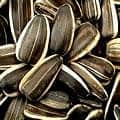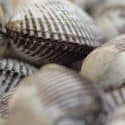Top 10 Foods Highest in Sodium

Sodium is an essential mineral required for maintaining fluid and electrolyte balance in the body, regulating blood pressure, and for the transmission of nerve impulses.
Deficiency of sodium is rare but can occur in people after excessive vomiting or diarrhea, in athletes who consume excessive amounts of water, or in people who regularly fast on juice and water.
Over-consumption of sodium is far more common and can lead to high blood pressure, which in turn increases the risk of heart attack and stroke.
The current daily value (DV) for sodium is 2300mg, however, the American Heart Association recommends that people with high blood pressure eat less than 1500mg per day or less than 3/4 of a teaspoon of salt.
Since sodium is required by all life to exist, it is naturally found in all foods and does not need to be added. Foods high in sodium include table salt, sauces, salad dressings, cured meats, bacon, pickles, bullion, instant soup, roasted salted nuts, snacks, fast foods, and canned foods.
Below is a list of high sodium foods. For more, see the extended lists of high sodium foods by nutrient density, list of high sodium foods to boost sodium levels, and the list of high sodium foods to avoid.
List of High Sodium Foods
 1 Table Salt
1 Table Salt| Sodium per Tsp | Sodium per 100g |
|---|---|
| 2325mg (101% DV) | 38758mg (1685% DV) |
- 52% DV in a tsp of baking soda
- 15% DV in a tsp of baking powder
 2 Cured Ham
2 Cured Ham| Sodium per Cup | Sodium per 100g | Sodium per 200 Calories |
|---|---|---|
| 2100mg (91% DV) | 1500mg (65% DV) | 1685mg (73% DV) |
More High Sodium Cured Meats
- 80% DV in 3oz of salami
- 56% DV in 3oz of pepperoni
- 40% DV in 3oz of baloney
- 36% DV in a 3oz chicken hotdog
See the list of high sodium meats.
 3 Ham and Egg Biscuit
3 Ham and Egg Biscuit| Sodium per Item | Sodium per 100g | Sodium per 200 Calories |
|---|---|---|
| 1989mg (86% DV) | 1093mg (48% DV) | 938mg (41% DV) |
More Fast Foods High in Sodium
- 81% DV in a Taco Bell taco salad
- 71% DV in a cheese burger
- 67% DV in an average slice of pizza
See the list of fast foods high in sodium.
 4 Pickled Cucumber
4 Pickled Cucumber| Sodium per Cup | Sodium per 100g | Sodium per 200 Calories |
|---|---|---|
| 1872mg (81% DV) | 1208mg (53% DV) | 21964mg (955% DV) |
More High Sodium Pickled Foods
- 95% DV in 1 cup of pickled eggplant
- 95% DV in 1 cup of jalapeno peppers
- 39% DV in 1 cup of sauerkraut
 5 Sunflower Seeds (Dry Roasted)
5 Sunflower Seeds (Dry Roasted)| Sodium per Oz | Sodium per 100g | Sodium per 200 Calories |
|---|---|---|
| 1706mg (74% DV) | 6008mg (261% DV) | 2201mg (96% DV) |
More Snacks High in Sodium
- 65% DV in 3.5oz of pretzels
- 25% DV in 1oz of beef jerky
- 15% DV in a Kellogg's Nutri-Grain Fruit Cereal Bar
See the list of high sodium snacks.
 6 Clams
6 Clams| Sodium per 3oz Serving | Sodium per 100g | Sodium per 200 Calories |
|---|---|---|
| 1022mg (44% DV) | 1202mg (52% DV) | 1624mg (71% DV) |
More Seafood High in Sodium
- 60% DV in a King crab leg
- 35% DV in 3oz of cooked shrimp
- 31% DV in a can of anchovies
See the list of seafood high in sodium.
 7 Canned Beans (With Added Salt)
7 Canned Beans (With Added Salt)| Sodium per Cup | Sodium per 100g | Sodium per 200 Calories |
|---|---|---|
| 880mg (38% DV) | 336mg (15% DV) | 595mg (26% DV) |
More Canned Foods High in Sodium
- 46% DV in 1 cup of canned shrimp
- 45% DV in 1 cup of canned chili with beans
- 36% DV in 1 cup of baked beans
- 32% DV in 1 cup of canned kidney beans
- 31% DV in 5 canned anchovies
 8 French Bread
8 French Bread| Sodium per Slice | Sodium per 100g | Sodium per 200 Calories |
|---|---|---|
| 837mg (36% DV) | 602mg (26% DV) | 443mg (19% DV) |
More High Sodium Baked Foods
- 20% DV in a slice of chocolate cake
- 17% DV in a bagel
- 15% DV in a slice of blueberry pie
See the list of baked foods high in sodium.
 9 Teriyaki Sauce
9 Teriyaki Sauce| Sodium per Tblsp | Sodium per 100g | Sodium per 200 Calories |
|---|---|---|
| 640mg (28% DV) | 1778mg (77% DV) | 3996mg (174% DV) |
More High Sodium Sauces
- 59% DV in a tblsp fish sauce
- 37% DV in tblsp of soy sauce
- 7% DV in a tblsp of BBQ sauce
 10 Grated Parmesan
10 Grated Parmesan| Sodium per Oz | Sodium per 100g | Sodium per 200 Calories |
|---|---|---|
| 512mg (22% DV) | 1804mg (78% DV) | 859mg (37% DV) |
More High Sodium Cheeses
- 21% DV per oz of Roquefort
- 20% DV per oz of American cheese
- 11% DV per oz of feta cheese
See the list of cheese and dairy high in sodium.
Printable One Page Sheet

Foods High in Sodium by Nutrient Density (100 Gram Serving Size)
This ranking lets you know which foods have the most Sodium per gram of food.
| Food | Serving | Sodium |
|---|---|---|
| 1 Table Salt | 100 grams | 1685% DV (38758mg) |
| 2 Sunflower Seeds (Dry Roasted) | 100 grams | 261% DV (6008mg) |
| 3 Soy Sauce | 100 grams | 239% DV (5493mg) |
| 4 Canned Anchovies | 100 grams | 159% DV (3668mg) |
| 5 Yeast Extract Spread (Marmite) | 100 grams | 147% DV (3380mg) |
| 6 Chili Powder | 100 grams | 125% DV (2867mg) |
| 7 Hot Sauce | 100 grams | 115% DV (2643mg) |
| 8 Salami | 100 grams | 98% DV (2260mg) |
| 9 Grated Parmesan | 100 grams | 78% DV (1804mg) |
| 10 Bacon | 100 grams | 73% DV (1684mg) |
Sodium Foods to Boost Your Sodium Level
| Food | Serving | Sodium |
|---|---|---|
| 1 Clams | per 3oz serving | 99% DV (2284mg) |
| 2 Pickles | per cup | 81% DV (1872mg) |
| 3 Sunflower Seeds (Dry Roasted) | per oz | 74% DV (1706mg) |
| 4 Black Bean Soup | per cup | 52% DV (1203mg) |
| 5 Manhattan Clam Chowder | per cup | 44% DV (1001mg) |
| 6 Cream of Asparagus Soup | per cup | 43% DV (981mg) |
| 7 Sauerkraut | per cup | 41% DV (939mg) |
| 8 Miso Paste | per tblsp | 28% DV (634mg) |
| 9 Grated Parmesan | per oz | 22% DV (512mg) |
| 10 Tomato Juice | per cup | 21% DV (481mg) |
| 11 Smoked Whitefish | per oz | 13% DV (289mg) |
| 12 Yeast Extract Spread | per tsp | 9% DV (203mg) |
| 13 Capers | per tblsp | 9% DV (202mg) |
High Sodium Foods to Avoid
| Food | Serving | Sodium |
|---|---|---|
| 1 Cured Ham | per cup | 91% DV (2100mg) |
| 2 Ham and Egg Biscuit | per item | 86% DV (1989mg) |
| 3 Chicken Sandwich | per item | 61% DV (1408mg) |
| 4 Canned Gravy | per cup | 59% DV (1357mg) |
| 5 Cured Meats (Pepperoni) | per 3oz | 58% DV (1345mg) |
| 6 Processed Chicken Breast | per 4 slices | 33% DV (748mg) |
| 7 Sausage Pizza | per slice | 32% DV (734mg) |
| 8 Teriyaki Sauce | per tblsp | 28% DV (640mg) |
| 9 Caesar Salad Dressing | per 2 tblsp | 19% DV (430mg) |
| 10 Large Soft Pretzel | per item | 13% DV (290mg) |
About the Data
Data for the curated food lists comes from the USDA Food Data Central Repository.
You can check our data against the USDA by clicking the (Source) link at the bottom of each food listing.
Note: When checking data please be sure the serving sizes are the same. In the rare case you find any difference, please contact us and we will fix it right away.
About Nutrient Targets
Setting targets can provide a guide to healthy eating.
Some of the most popular targets include:- Daily Value (%DV) - The daily value (%DV) is a general guideline for consumption that will prevent deficiency of a particular nutrient in most people. The %DV refers to the percentage of an amount that's found in a single serving of a food. It also accounts for absorption factors. It is set by the U.S. FDA.
- Recommended Dietary Allowance (%RDA) - The RDA sets an average daily dietary intake level that is sufficient to meet the nutrient requirements of nearly all (97.5%) healthy individuals. It's more specific than the daily value, and varies by age and gender. The RDA is set by the US National Instutites of Health.
- Reference Dietary Intake (%RDI) -The reference dietary intake is similar to the recommended daily allowance, but is specific to age and gender. The RDI for amino acids is set by the U.N. World Health Organization.
- Adequate Intake (%AI) - This value is primarily used in reference to omega-3 and omega-6 fats. The Adequate Intake is set by the U.S. Institute of Medicine. Because there is less evidence to determine the ideal targets for consumption of these nutrients, the specific amount is considered to be less reliable. Using the term Adequate Intake, rather than one of the other terms, helps to emphasize that the ideal intake of that particular nutrient has not yet been scientifically determined.
See the Guide to Recommended Daily Intakes for more information.
Want to set your own targets? Sign up for an account and set custom targets in the daily meal planner.From the Nutrient Ranking Tool
Use the ranking tool links below to select foods and create your own food list to share or print.
- Foods High in Sodium
- Foods Low in Sodium
- Vegetables High in Sodium
- Fruits High in Sodium
- Vegetarian Foods High in Sodium
- Nuts High in Sodium
- Grains High in Sodium
- Beans High in Sodium
- Dairy High in Sodium
- Breakfast Cereals High in Sodium
- Fast Foods High in Sodium
View more nutrients with the nutrient ranking tool, or see ratios with the nutrient ratio tool.
Related
Data Sources and References
Try the recipe nutrition calculator, or daily meal planner.
Create a free account to log and track foods.
